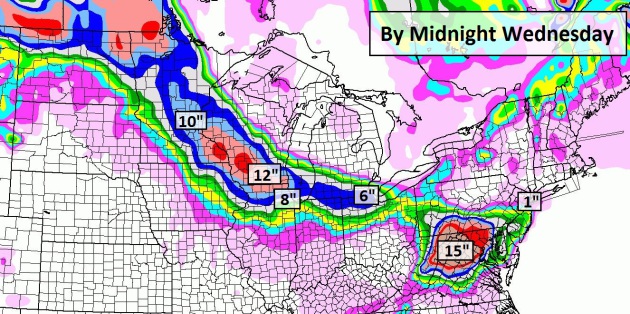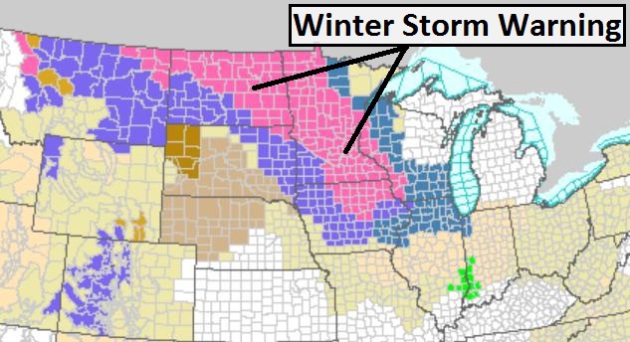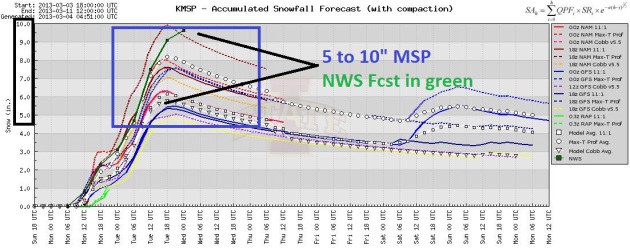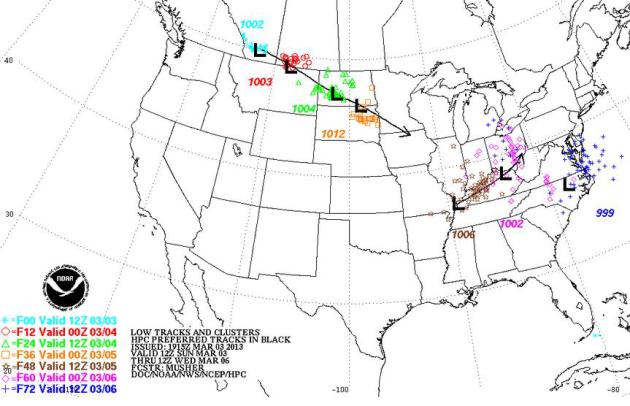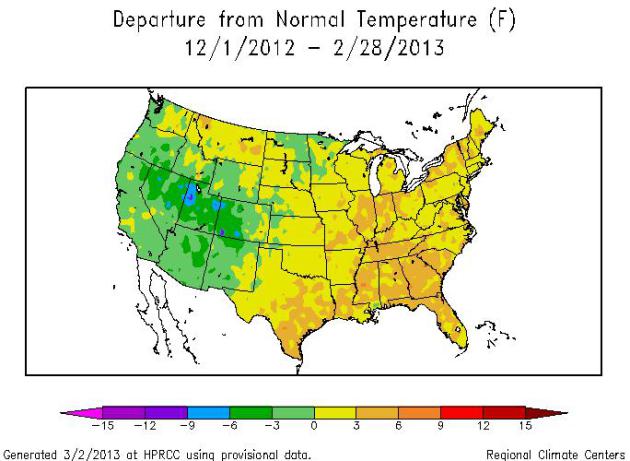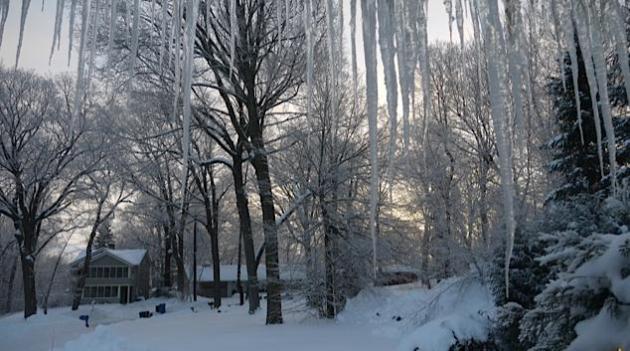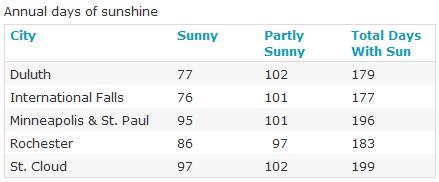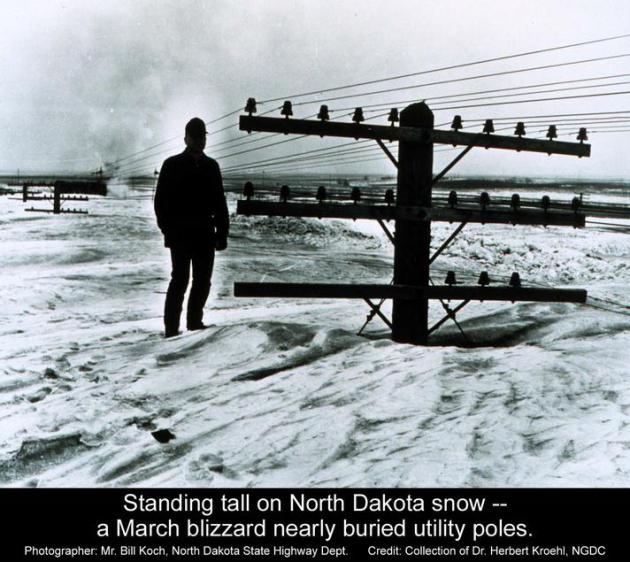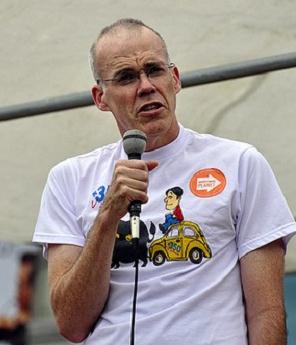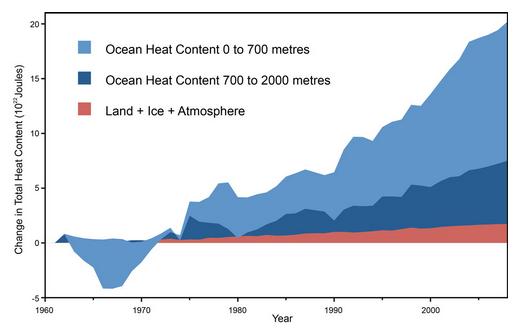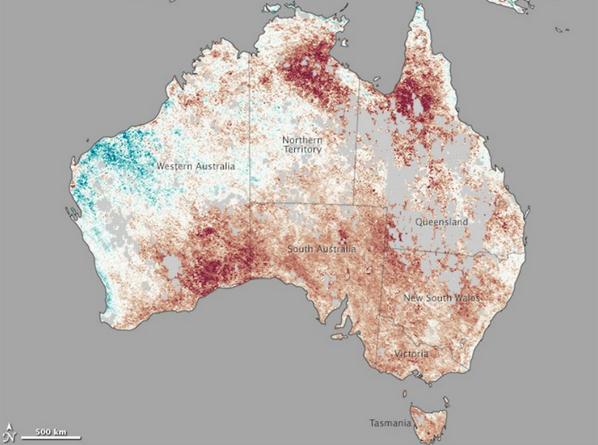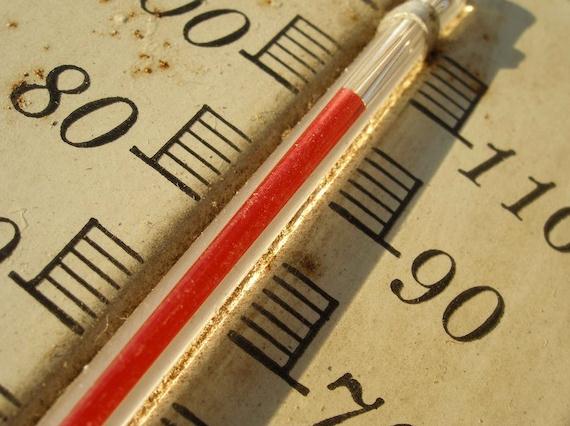Very Plowable
I wish I could see your face as you read this.
Maybe it's best I can't. Grin? Or grimace? High five - or a stream of
spank-worthy expletives? March snows are a Rorschach test for
Minnesotans. Many find them annoying; I look at the maps and get
encouraged.
Why? Last March brought 70s and 80s; the warmest March on record was an omen for record heat & drought later that summer.
Not so in 2013. A parade of storms into spring
is required to pull us out of a potentially debilitating drought. Think
of this as cold, white Manna from Heaven. Theoretically possible, until
you get into your car.
We should have 4 to 5 inches of wet snow by
tonight, another 2-4 inches early Tuesday. Plowable, but hardly
crippling. Leave extra time, extra space on the freeways, and please tip
your waiter.
Chicago picks up 8 inches, maybe 4-8 inches in
Washington D.C. - which qualifies as a natural disaster. Mother Nature
is about to sequester members of Congress.
We thaw out later this week; more sloppy snow brewing 1 week from today.
Most of this delightful, concrete-like slush
will run off before it can soak into dusty topsoil. But some pain on the
freeways now means drought may be easing.
* photo credit above: upper left: St. Cloud Times - upper right: Wikipedia.
A Respectable Pile of White. WSI Corporation's 12
km. RPM model prints out some 10" snow amounts just west of the metro
area, a 150-200 mile wide band of at least 6" of snow, closer to 8"+ for
much of central, east central and southeastern Minnesota and a vast
swath of Wisconsin. As much as 12-16" snow is possible from Madison and
Milwaukee to Chicago and South Bend, Indiana. Great fun! Especially at
O'Hare and Midway. This will be a good 48 hour period to take Amtrak.
One Beefy Clipper. You're picturing a plus-size
barber? Who writes this crap? Oh, I do. Sorry. What this Alberta Clipper
lacks in moisture it will make up for in speed, or I should say a lack
of speed. This system is limping along, and a 36+ period of snow will
result in plowable snowfall amounts from Minnesota into Wisconsin,
northern Illinois and Indiana and the Detroit area. Washington D.C. may
pick up as much as 5-10" Wednesday, with a foot for the far
northern/western suburbs. Looks like Old Man Winter is about to
sequester our nation's capitol.
The Best Clipping In Years. NOAA has issued Winter
Storm Warnings from much of North Dakota into a big stretch of
Minnesota, western Wisconsin and northern Iowa, meaning heavy snow and
treacherous travel is imminent. Details:
.SNOWFALL ACCUMULATIONS OF 6 TO 10 INCHES ARE EXPECTED ACROSS
MUCH OF CENTRAL AND SOUTHERN MINNESOTA AND FAR WESTERN WISCONSIN
DEVELOPING TONIGHT AND LASTING THROUGH TUESDAY...AS A WINTER
STORM MOVES ACROSS THE NORTHERN PLAINS AND UPPER MIDWEST. SOME
STORM TOTALS COULD APPROACH 12 INCHES DEPENDING ON WHERE PRIMARY
SNOW BANDS SET UP.
THIS SNOWFALL LOOKS TO BE SPLIT UP INTO TWO WAVES OF SNOW. THE
FIRST WILL COME TONIGHT THROUGH MONDAY MORNING...WITH A SECOND
ROUND EXPECTED MONDAY NIGHT THROUGH TUESDAY MORNING. SNOWFALL
RATES ARE EXPECTED TO DECREASE FOR A PERIOD MONDAY AFTERNOON AND
EVENING BETWEEN THESE TWO WAVES.
...WINTER STORM WARNING REMAINS IN EFFECT UNTIL NOON CST
TUESDAY...
A WINTER STORM WARNING REMAINS IN EFFECT UNTIL NOON CST TUESDAY.
* TIMING: TWO PERIODS OF MODERATE SNOW EXPECTED THIS EVENING INTO
MONDAY MORNING AND AGAIN MONDAY NIGHT. SNOW WILL SLOWLY DIMINISH
TUESDAY MORNING.
* MAIN IMPACTS: SNOW ACCUMULATION OF 6 TO 10 INCHES.
* OTHER IMPACTS: SOUTHEAST WINDS GUSTING TO AROUND 25 MPH WILL
RESULT IN SOME BLOWING AND DRIFTING SNOW IN OPEN AREAS.
PRECAUTIONARY/PREPAREDNESS ACTIONS...
A WINTER STORM WARNING FOR HEAVY SNOW MEANS SEVERE WINTER WEATHER
CONDITIONS ARE EXPECTED OR OCCURRING. SIGNIFICANT AMOUNTS OF
SNOW ARE FORECAST THAT WILL MAKE TRAVEL DANGEROUS. ONLY TRAVEL IN
AN EMERGENCY. IF YOU MUST TRAVEL...KEEP AN EXTRA FLASHLIGHT...
FOOD...AND WATER IN YOUR VEHICLE IN CASE OF AN EMERGENCY.
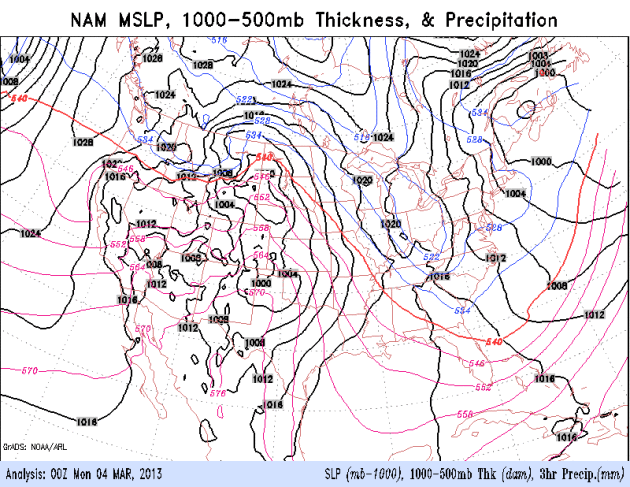 Sputtering Along.
Sputtering Along.
A typical Alberta Clipper moves at 20-35 mph, leaving little time for
snow to accumulate, in fact most clippers just whip up gusty winds which
kick around the snow that's already on the ground. But this system is
limping along at 10-15 mph, meaning a much longer period of snow from
the Upper Midwest into the Great Lakes; eventually regenerating into a
coastal storm capable of dumping 5-10" or more on Washington D.C. New
York City may be spared, with only an inch or two by Thursday, but it
will be a very close call.
Model Spread. Keep in mind that clippers are
extremely fickle; a slight deviation in the storm track will make a big
difference in final snowfall totals. That said, I don't see how we don't
pick up a plowable snowfall (at least 3-4"), and I'm still comfortable
(wrong word) predicting a final tally in the 5-10" range by Tuesday
afternoon or evening.
Storm Track. You can see the various models and
their predictions of where/when the Alberta Clipper will be centered
looking out 72 hours. The heaviest snowfall amounts are likely just
north of the storm track. Map: NOAA.
Bad News For No-Way and O'Hairy Airports. Flying
thru Chicago Midway or O'Hare Tuesday? Just wave a little white flag of
defeat now, because I don't think it's going to happen. Latest models
show 7-10" for Chicago, more just north of the city.
A Rough Winter? Not So Much. NOAA's Regional Climate
Center shows a warmer than average winter east of the Rockies;
temperatures as much as 3F warmer than normal from the Midwest into the
Southeast. The western third of the USA has been trending colder since
December 1. My sources tell me that, as of Feb. 23, national temperatures since December 1 are running .64 F. warmer than average.
Preliminary February Climate Summary. Here's an excerpt of Mark Seeley's always-excellent weekly edition of
WeatherTalk: "
Most
observers in Minnesota reported a mean monthly temperature for
February that was 2 to 4 degrees cooler than normal. Since June of 2011
(a 21 month period), February 2013 is only the 2nd month with a
statewide average temperature that is cooler than normal (the other was
October 2012). Extremes for the month were 45 degrees F at Grand
Rapids on the 27th and -39 degrees F at International Falls on the 2nd.
Precipitation was generally abundant during the month of February,
except for small portions of southwestern Minnesota. It was the wettest
February statewide since 2007. Many observers reported over 2 inches
of precipitation, most of which came as snowfall..."
How The Sequester Impacts Weather And Hurricane Reporting. Here's a story that caught my eye; an excerpt courtesy of
Central Florida News 13: "
How
you are protected and receive information about extreme weather
conditions from the government could be affected by the sequester. The
National Oceanic and Atmospheric Administration, which runs the
National Weather Service and the National Hurricane Center, stands to
take a large hit if the sequester takes effect, according to the Obama
administration. The Department of Commerce, oversees NOAA, stated that
the budge cuts could potentially impact the public in a storm. In an
emailed statement, a spokesman wrote:
“These cuts would result in a gap in
weather satellite coverage, diminishing the quality of weather forecasts
and the warnings of severe weather events like hurricanes and
tornadoes...These impacts directly affect NOAA employees and
partners throughout the country: up to 2,600 NOAA employees would have
to be furloughed, approximately 2,700 positions would not be filled,
and the number of contractors would have to be reduced by about 1,400.
If sequestration is enacted, NOAA will face the loss of highly trained
technical staff and partners. As a result, the government runs the risk
of significantly increasing forecast error and, the government's
ability to warn Americans across the country about high impact weather
events, such as hurricanes and tornadoes, will be compromised..".
Photo credit above: "
(FILE/Kimberly Prosser, Brevard County Emergency Management) "Hurricane
hunter aircraft like this one in Brevard County could be forced to
reduce flight hours under budget cuts as outlined in the March 1, 2013
sequester."
Percentage Annual Sunshine. The list above
highlights America's sunniest cities. Phoenix and Las Vegas get top
honors for the most sunshine (85% of daylight hours are sunny, on
average). As a point of comparison 58% of daylight hours in the Twin
Cities are clear to partly cloudy, a higher number than Chicago,
Milwaukee, Detroit or Boston. Source:
currentresults.com.
If Anyone Asks (Doubtful) St. Cloud Is Sunnier Than The Twin Cities. Who knew? I dug around the
currentresults.com web site and found the nugget above: St. Cloud is the sunniest (large) city in Minnesota. It should be a trivia question.
2012 U.S. Extreme Weather Overview. Here's a portion of an excellent recap and summary (PDF) of America's weather extremes during 2012 from
Climate Nexus: "
With
oppressive heat waves, devastating droughts, ravaging wildfires, and
hard-hitting storms, 2012 was one for the record books. Thousands of
precipitation and temperature records were broken, plaguing almost all
of the United States this year and underscoring the connection between
increasingly frequent and intense extreme weather and climate change.
With climate change, we’ve set the table for precisely this kind of
extreme weather, and unfortunately, our changing climate threatens to
alter the weather for years to come.
A year of extremes: 2012 was the second
most extreme year on record for the nation, according to the
U.S.Climate Extremes Index. The year had 11 disasters costing $1 billion
or more. The only year on record that had more billion dollar disasters
was 2011, which had 14. According to Munich Re, extreme weather caused
$107.2 billion worth of damage in the U.S in 2012...."
Going Blind: The Coming Satellite Crisis. The USA
has 24 earth-observing satellites in orbit right now; several of the
polar-orbiting satellites are about to go dark, and replacements may not
be available for a period of time, resulting in a potential
forecast-accuracy-gap. Some predictions have only 6 earth-observing
satellites in operation by 2020. More from
PBS Nova: "...
That’s
where polar orbiting satellites come in. They complement geostationary
satellites by trading frequent updates for sharper images. Polar
orbiting satellites sit much closer to Earth—generally about 500 miles
up—and complete a trip around the globe every 100 minutes or so. Most
Earth-observing satellites, weather and otherwise, fly in polar orbits.
With the right sensor, they can image the entire planet twice a day,
once on the day side, once on the night side. Their role in meteorology
is unquestionable. “The polar orbiting satellites give us the ability
to do long term weather forecasts,” says Jane Lubchenco, outgoing
administrator of the National Oceanic and Atmospheric Administration.
“Currently, NOAA’s forecasts go out 7 to 10 days. If we don’t have a
polar orbiting satellite, we would do 2 to 3 day forecasts. That’s a
huge difference...”
Image credit above: "
Suomi NPP is a weather satellite in low-Earth orbit—the only one the U.S. currently operates for civilian uses."
The King Tides. What Happens When The Sea Level Rises. This is the first I've heard the expression "King Tides"; here's a segment of an article at
Huffington Post: "
Did
California just get a glimpse of what future sea level may look like?
California experienced King Tides, especially high tides, during early
February. The King Tides come three times a year, predicted because of
the orbit and alignment of the Earth, sun, and moon. I was interested
in tracking them because I am an advocate for low-lying islands and
coastal communities, and I frequently write about issues facing these
islanders from an eyewitness perspective. The timing of the latest King
Tide in California turned out to be poignant, as the Solomon Islands
experienced an earthquake and subsequent tsunami that took lives and
again challenged the world to think about the way communities are
shaped and sometimes traumatized by the water..."
Photo credit above: "
Drowning Islands Facebook fan Tracey
Coleman took this before and after photo in San Clemente, California to
highlight the before and after effect of the King tide. Of all the
submissions received, this was my favorite - what a great shot."
How Much? No, not this much either. Photo from the
early 60s, courtesy of Bill Koch, North Dakota State Highway Department.
Credit: Dr. Herbert Kroehl, NGDC.
Climate Stories...
The Crisis In Climate Change Coverage. Is the
mainstream media doing a good job communicating the urgency of the
threat. A well organized, well-funded group of climate deniers is doing a
good job raising doubt and confusion, even though a majority of
Americans are seeing the manifestations of warmer, stormier atmosphere
outside their windows. Here's an excerpt of a story at
truth-out.org: "...
A
complex mix of structural and cultural factors has affected
climate-change coverage in the U.S. The forces that shape U.S. media
have not been kind to environmental reporting. Years of media
consolidation have led to dramatic layoffs in commercial newsrooms, and environment and science desks are often the first to go.
In addition, M. Sanjayan noted that media consolidation has had an
echo-chamber effect: All climate stories sound the same and they lack
depth, specificity and connection to place. The U.S. also under-funds
noncommercial alternatives, like public media, where climate-change
reporting should thrive. The best environmental writing is happening at
the margins of our media at longtime nonprofit magazines and new online startups. In contrast, mainstream outlets have tended to legitimize climate-change deniers
in the face of widespread scientific consensus about the effects of
global warming. Wen Stephenson argued that journalists have been
reticent to raise the alarm about climate change. “The mainstream media
has failed to cover the climate crisis as a crisis,” he said..."
Permafrost: Climate Change Time Bomb. We're in
uncharted waters: carbon that took hundreds of millions of years to form
into coal, oil and natural gas is being burned and released back into
the atmosphere in less than 100 years, a geological blink of an eye. If
permafrost at far northern latitudes melts sufficiently to release vast
quantities of methane things could get really interesting. Here's a NASA
video clip, courtesy of
theenergycollective.com: "
Recent research
from a team of Russian scientists reports that a 1.5°C rise in global
temperature is enough to melt permafrost in Siberia and throughout the
Arctic. As permafrost melts it releases greenhouse gases and could
likely push climate change across a tipping point beyond human control.
This video from the Yale Climate Forum looks at the state of permafrost and the consequences on climate as it melts in an increasingly warming Arctic."
"No Warming" For The Last 15 Years? Think Again.
It's a favorite denier-meme, but a true and accurate calculation of heat
balances has to include the world's oceans, where the vast majority of
warming has been observed. Here's an explanation from
Skeptical Science: "
As
we have discussed many times at Skeptical Science, although the
warming of global surface air temperatures has slowed over the past
decade due to a preponderance of La Niña events, the rate of heat accumulation on Earth has not slowed at all.
In fact over the past 15 years, the planet has accumulated more heat
than during the previous 15 years. That's global warming. Unfortunately many people (often even including climate scientists) mistakenly equate the warming of global surface air
temperatures with global warming. That is simply
inaccurate. Approximately 90% of global warming goes into heating the
oceans..."
Graphic credit above: "
Land, atmosphere, and ice heating (red), 0-700 meter OHC increase (light blue), 700-2,000 meter OHC increase (dark blue). From Nuccitelli et al. (2012)."
1 in 500 Probability Extreme Summer Weather in Australia was "Natural".
Record heat and extreme rains Down Under over the last few months -
just how unusual was it? Here's a clip of a story at Australia's
The Age: "
A
few years ago, talking about weather and climate change in the same
breath was a cardinal sin for scientists. Now it has become impossible
to have a conversation about the weather without discussing wider
climate trends, according to researchers who prepared the Australian
Climate Commission's latest report. The report, The Angry Summer, says
behind the litany of broken heat and rainfall records this year, a
clear pattern has now emerged. ''Statistically, there is a one in 500
chance that we are talking about natural variation causing all these
new records,'' said Will Steffen, the report's lead author and director
of the Australian National University's Climate Change Institute.
''Not too many people would want to put their life savings on a 500-1
horse...''
Graphic credit above: Australia just experienced it's hottest
summer season on record. The satellite-derived map above, from
Australia's Burea of Meteorology, shows temperature anomalies for the
first week of January. The dark red areas depict surface temperatures as
much as 27 F. warmer than average.
The Atlantic Cities has more details on a summer to remember.
Trapped As Climate Changes, Giant Gusts Of Hot Air Trigger Weather Extremes. Here's the intro to a story at
smithsonian.com that caught my eye: "
During the month of July 2011, the United States was seized by a heat wave so severe that roughly 9,000 temperature records were set, 64 people were killed and
a total of 200 million Americans were left very sweaty. Temperatures
hit 117 degrees Fahrenheit in Shamrock, Texas, and residents of Dallas
spent 34 consecutive days stewing in 100-plus-degree weather. For the
past couple of years, we’ve heard that extreme weather like this is tied to climate change, but until now, scientists weren’t sure exactly how the two were related. A new study published yesterday in the journal Proceedings of the National Academy of Sciences
reveals the mechanism behind events such as the 2011 heat wave. What it
comes down to, according to scientists at Potsdam Institute for
Climate Impact Research (PIK), is that higher temperatures caused by
global warming are disrupting the flow of planetary waves that
oscillate between Arctic and tropical regions, redistributing the warm
and cold air that usually help regulate the Earth’s climate. “When they
swing up, these waves suck warm air from the tropics to Europe, Russia,
or the US, and when they swing down, they do the same thing with cold
air from the Arctic,” lead author Vladimir Petoukhov of PIK explained in a statement...."
Photo credit above: "
Scientists have identified a link between global warming and extreme weather events such as heat waves." Photo by Flickr user
perfectsnap
Our View: America, Pick Your Climate Choices. Climate deniers and birthers in the same Op-Ed? Here's an excerpt from
USA Today: "
One
way to deal with a problem is to pretend it doesn't exist. This
approach has the virtue of relieving you from having to come up with a
solution, spend money or make tough choices. The downside, of course, is
that leaky faucets and other problems rarely solve themselves and, in
fact, usually get worse if ignored. Such is the case with climate
change, a threat that too many members of Congress, most of them
Republicans, have decided to manage by denying the science. That
head-in-the-sand approach avoids messy discussions of higher energy
prices, but it just got harder to justify..."
Climate Change, Conflict and TV Weather. Don't get
me started. I began talking about climate change and the trends I was
witnessing with Minnesota's increasingly manic weather back in the late
90s on WCCO-TV. I was looking at science, not policy implications or
politics, but even then there were some who saw this as evidence of a
vast, global conspiracy. Since then more TV meteorologists are talking
about climate change on the air, but it's a daily struggle. Why? Not
enough time allotted to accurately tell the story, and a desire to be
loved (by all). Because when you start talking about climate change on
the air you just know that 20-30% of viewers, especially older viewers,
will see this as a negative. Ratings and research drive local TV news;
every news director I've ever worked with told me "not to be
controversial". No negatives. Which is why talking about climate trends
can be kryptonite for TV meteorologists. Here's an excerpt of an article
from
NCAR: "...
Yet
in a 2011 survey of more than 400 weathercasters led by GMU’s Edward
Maibach, only 19% agreed that global warming was real and primarily
caused by humans, whereas 35% felt it was due to a mix of human and
natural causes and 29% believed it was primarily a natural phenomenon.
To get a clearer picture of what’s motivating or demotivating
weathercasters, the GMU group conducted 49 in-depth interviews with
weathercasters and moderated a workshop that drew on methods used for
conflict analysis and resolution. Analyzing their feedback, Schweizer
identified three main types of barriers.
- Occupational: Given that local TV news is a
highly competitive business, some weathercasters fear that discussing
climate change could cast them or their stations in a negative light.
- Social: Because climate change is such a highly charged topic, there’s a natural tendency to avoid conflict by avoiding the subject.
- Cultural: Among the 35% of weathercasters
in the above-mentioned survey who cited both natural and human factors
in climate change, many stressed the uncertainties inherent in any
research conclusion. Some also feared that politics might be affecting
the research itself, including the ways in which scientists presented
and discussed their policy-relevant findings. The 29% of weathercasters
who viewed climate change as primarily natural had even deeper
reservations about the process of climate science, including peer
review and funding decisions..."
Photo credit above: "
Gary Lezak (KSHB, Kansas City) is
among TV weathercasters who deliver occasional reports on the global
and local implications of climate change." (©UCAR. Photo by Carlye Calvin).
Why You Should Sweat Climate Change.
USA Today has some good interactive graphics that help to tell the climate story and the implications of a warmer, stormier pattern.


